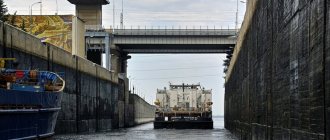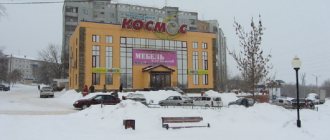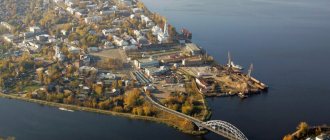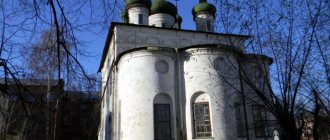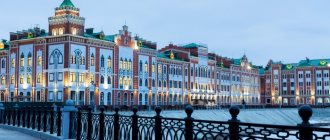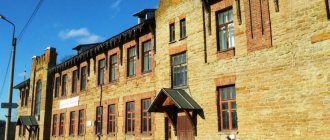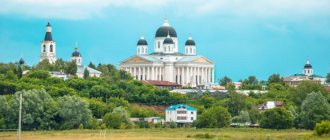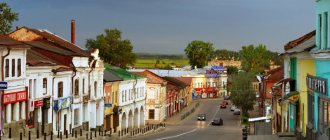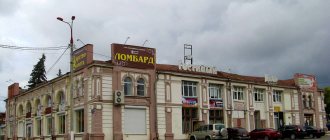Balakovo is one of the largest cities in the Saratov region, second only to the regional capital and Engels. It is located partly on the left bank of the Volga, partly on an island. It is separated from the regional center by 176 kilometers in a straight line, this is not the longest distance for the Volga regions.
The territory of the city is 75 square kilometers. Communication with surrounding cities is ensured by the operation of a bus station, railway station, and river port.
Districts and real estate of Balakovo
Internally, the city is divided into three parts: island (residential town, old town and Dzerzhinsky village), canal (from 1 to 4 microdistricts and the village of Sazanley) and central (from 5 to 11 microdistricts and the village of Raduzhny).
Old city
The residential town is divided from the central and canal parts by a shipping canal, which divides the city, as it were, in half. There is only one bridge connecting the old part of the city with the new one (it is called the sluice bridge), which is not very convenient for the townspeople: during rush hours traffic jams often form on the bridge, and it takes a lot of time, for example, to come from the 11th microdistrict to the village of Dzerzhinsky .
Sluice Bridge
True, in the next year or two the problem should disappear. Balakovo residents will receive the long-awaited second bridge across the shipping canal. The first stone in the construction of the future bridge was laid at the beginning of the two thousandth under pompous speeches of local officials and Vyacheslav Volodin (then a deputy of the regional Duma, and now the vice-speaker of the State Duma). Since then, construction has been started, then frozen, and then unfrozen again years later. Fortunately, construction is now actively underway, and if you believe the promises of regional and local politicians, the bridge will be put into operation at the beginning of 2014.
New neighborhoods
The cost of apartments in the city of Balakovo does not “jump” much and remains approximately at the same level. A “one-room apartment” here, depending on the location of the house in which it is located, can be purchased from 800 to 1,500 thousand rubles. The price of a two-room apartment ranges on average from 1 million 200 thousand rubles to 2 to 2.5 million. Apartments in new areas (especially in new buildings in microdistrict 11) are more expensive than similar housing in other areas of the city. In general, housing prices in the central part of the city are higher than for apartments in the island part. Although in the residential city there are streets where apartments are considered more prestigious than in other parts of the city. These include Lenin Street and Torch of Socialism.
Border of the old town and residential town
In the village of Dzerzhinsky, which is located within the city, housing is cheaper. There are several reasons for this. Firstly, this is one of the oldest areas of the city, the housing here is mostly dilapidated. The infrastructure here is less developed than in other parts of the city.
In addition, the reluctance to purchase housing here is determined by the reluctance to communicate and generally encounter the local contingent. This is one of those areas where in the evening, if you don’t answer affirmatively to the question: “Hey, do you have anything to smoke?”, you run the risk of being beaten. This is one of the most crime-ridden areas of the city. Now things are somewhat better, but in the late nineties and early 2000s, gangs of teenagers operated here, lovers of the “green snake” sat on the benches, and those who served time and, ideally, “hit the hairdryer” were held in high esteem. Balakovo residents simply call Dzerzhinsky’s village “Dzerzhukha.”
The microdistricts of the canal part of the city (microdistricts 1, 2, 3, 4) are also considered not the most prosperous. The houses here are mostly in need of repair (except for the nine-story building on Kakhovskaya Street), and acts committed in apartments and on the streets of these microdistricts often end up in crime reports. Although it would be wrong to think that it is simply impossible to walk down the street here without a pistol or a stun gun in your bosom. It just so happens that these areas are considered less prosperous.
View of the nuclear power plant
Purchasing housing in microdistricts 5, 5A, 6, 7, 8, 8A, 9, 10 and 11 is more prestigious. They are considered central. The infrastructure here is more developed, the streets are cleaner and more well-groomed (as far as the terms cleanliness and well-groomedness are generally applicable to Balakovo). You can also find rental housing in Balakovo. On average, the monthly price for a one-room apartment ranges from 8 to 12 thousand rubles (depending on location). Prices for renting housing jumped significantly when non-resident workers arrived in Balakovo to build the Severstal Long Product Plant Balakovo enterprise. Demand creates supply, and the demand for rental housing with their arrival was simply frantic. Then prices increased one and a half to two times, and they remain at that level.
"Severstal - Balakovo Long-Product Plant"
Not far from the 7th microdistrict is the village of Raduzhny. It is fenced off from “mere mortals” and carefully guarded. This is a cottage community, where houses are mainly purchased by high-ranking nuclear scientists and other “owners of factories, newspapers, and ships.” To buy a house here, you need to have more than one million and, most likely, not even ten... Local residents call this village “Ipatovka”, in honor of the former director of the Balakovo Nuclear Power Plant and the former governor of the Saratov region, Pavel Ipatov.
Village "Rainbow"
Enterprises and work in Balakovo
Balakovo is an industrial city. First of all, it is worth mentioning two giants - enterprises of all-Russian significance: the Balakovo Nuclear Power Plant and the Saratov Hydroelectric Power Plant. These giants always worked stably, without blues and worries. Salaries at these enterprises are higher than the city average. But getting a job here without cronyism or connections is almost impossible. And although representatives of these enterprises claim that this is not so, the majority of Balakovo residents know very well that the positions of nuclear and hydropower engineers are filled “from father to son” or in other ways of family and friendship.
Balakovo NPP
Now in Balakovo the construction of the Severstal - Balakovo High-Products Plant is in full swing. It should start working soon. Officials talk about the fabulous sums that the enterprise will pay to the budget in the form of taxes, and residents are sounding the alarm, fearing for the already not-so-good environment. Other enterprises include (now going through hard times), Balakovo Mineral Fertilizers, Thermal Power Plant 4. In total, there are about 15 large enterprises and many medium and small enterprises in the city.
Saratov HPP
According to official data, the average salary in Balakovo is about twenty thousand rubles. However, in fact, most city residents receive 10-15 thousand rubles (many less). The average salary figure is this way because giants like nuclear power plants and hydroelectric power plants (where salaries are many times higher than at other enterprises and organizations in the city) are involved in the calculation. It’s like the joke: “My boss eats meat, and I eat cabbage, but on average we both eat cabbage rolls.”
Balakovo museums and theaters
Balakovo residents owe much of their cultural life to Saratov. The regional center shared museum funds with Balakovo, but the city itself also has unique historical objects and valuable exhibits.
Museum of History
- Address: Kommunisticheskaya st., 100.
The main museum of Balakovo is located in a one-story red brick house. The interesting building immediately catches the eye thanks to the corner turret with a high cone-shaped roof, which is crowned with a weather vane. The unusual mansion in the neo-Gothic style was built at the beginning of the 20th century and belonged to V.V. Golovanov, a local entrepreneur, banker and grain industrialist.
The Balakovo Museum opened in 1986 as a branch of the Saratov Museum of Local Lore. At first, the regional center transferred part of its funds to the younger brother, later, thanks to local historian A.A. Derevyanchenko, exhibits related to the history of Balakovo itself appeared in the museum. Inside, visitors will find exhibitions of antique furniture, clothing, dishes, books and other household items.
Art Gallery
- Address: Zaovrazhnaya st., 9.
The unassuming building from the late 19th century houses treasures of fine art. Initially, the building housed the Commercial and Industrial Bank; after the Revolution, the premises were confiscated and turned into a branch of the Saratov Museum. Like the original museum, the Balakovo branch is named after the writer and political figure A. N. Radishchev.
This name was given to the museum by its founder A.P. Bogolyubov, who was a close relative of the writer. The art gallery opened to visitors in 1977. Most of the collection are creations of Russian painters.
Drama Theater named after. E. Lebedeva
- Address: st. Titova, 2.
The only Balakovo professional theater began its work in 1997. The troupe included both beginning actors and experienced artists from Russia and Kazakhstan. Initially, the theater was called “Kovcheg”, but later received the name of the famous Balakovo resident, actor Evgeny Lebedev.
Theatrical performances diversified the cultural life of the city and quickly gained popularity among local residents. The drama theater is suitable for all age categories, as its repertoire includes performances for both adults and children.
Crime
The crime situation in the city can hardly be called difficult. Although weekly police reports contain information about thefts, robberies, and fraud. One of the high-profile cases, which was even reported on by central channels, is connected with a gang of “black realtors.” Gang members looked for lonely pensioners, socially disadvantaged people and arranged the “disappearance” of these citizens, criminally registering their real estate in the name of the right people.
Recently, the head (now former) of the Balakovo district administration also distinguished himself. He, taking advantage of his official position, made sure that one of his deputies received a three-room apartment (he even managed to privatize it). The court declared the official’s actions illegal and made a truly “strict” decision - he banned the culprit from holding leadership positions in government structures for two years.
Automobile highways
The following roads pass through Balakovo:
- P228 is a federal highway with a total length of 678 km. The route passes through the territory of the following regions: Volgograd region, Ulyanovsk region, Samara region, Saratov region. The road surface is asphalt.
- 63Р-00002 is a highway of regional importance, which passes through the territory of the Samara, Volgograd and Saratov regions. The total length of the route is 792 km. The road surface of route 63Р-00002 is asphalt.
Balakovo: what you must see on your own
The most significant sights of Balakovo are associated with the two main values of the city - history and industry.
Saratov hydroelectric power station and gateways
- Address: Zaovrazhnaya st., 10.
In the 1960s In Balakovo, on the banks of the Volga, a hydroelectric power station was built. The monumental construction required a lot of effort and resources; the work lasted 15 years. The resulting reservoir became the largest in the Saratov region. For more than half a century, the hydroelectric power station has been supplying water and electricity to local industry.
At the same time as the hydroelectric power station, builders built locks, from which a shipping embankment eventually stretched to the Drama Theater. Locals and visitors love to stroll along the embankment, watching the passing ships from above. From here there are some excellent views for photography.
House-Museum of V.I. Chapaeva
- Address: Chapaeva, 112.
Balakovo is the small homeland of Vasily Chapaev. This is where the red commander’s parental home is located, where he lived since he was 10 years old. The house is a small wooden hut; the windows have carved frames and shutters. The building preserved original items that belonged to the family of Vasily Ivanovich. Before the Civil War, the future commander worked as a carpenter; in one of the rooms you can see a sideboard made by the hands of a Soviet hero.
Many important events in Chapaev’s life are connected with this home. Here he brought his wife, who bore him two sons and one daughter, and from here he went to the front. While Vasily was fighting, his father was in conflict with his daughter-in-law. The young woman ran away more than once, but each time she had to return to her father-in-law. In the end, unable to withstand the pressure, his wife divorced Chapaev, leaving him with the children. After the death of Vasily Ivanovich, his daughter lived in the hut. In 1948, a museum in memory of the people's favorite was organized in the house.
Maltsev Estate
- Address: Kommunisticheskaya, 75.
Balakovo is rightly called a merchant city. Many beautiful buildings appeared in the settlement thanks to merchants, in particular, thanks to the famous Maltsev dynasty. One of the best examples of ancient architecture is the mansion of Paisiy Maltsev, the richest and most influential Balakovo resident of the late 19th and early 20th centuries.
Two talented architects worked on the appearance of the manor house at different times: F. Shuster and F. Shekhtel. The first built the mansion in the 1890s, the second was involved in its reconstruction in 1912. Shekhtel turned a modest provincial house into an exquisite palace in the spirit of aristocratic St. Petersburg.
After the Revolution, the estate began to be used for the needs of the Communist Party and the working people. At first, the district committee met in the mansion, and later a library was located. In 1998, the noticeably dilapidated building was handed over to restorers. Ten years later, the merchant's house turned into a museum.
The luxurious interior of the mansion amazes with its splendor. The one-story manor house is adjacent to a fairly large area, which includes a servants' house, a laundry room, a stable, a carriage house and a garden. Near the mansion there are lilac bushes planted about a hundred years ago.
